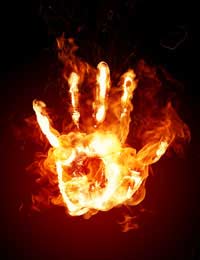All About Pyrokinesis

Fire is a universally fearsome element, one with a great deal of power attached to it; with fire, mankind can rise above the animals and create a world in his image. On the flip side, with fire, mankind can be hurt, crippled and destroyed. The ability to control fire in any form is a symbol of power and the ability to control fire simply by thinking about it is the power behind Pyrokinesis.
What is Pyrokinesis ?
Pyrokinesis comes from the Greek words for fire (Pyro) and movement (kinesis), suggesting control. In some traditions a pyrokinetic (a person who can employ pyrokinesis) can create fire, but “technically” a pyrokinetic can only manipulate fire, although they can ignite flammable substances, creating fire after a fashion. The ability to create fire from thin air, with no flammable substances, would be called “pyrogenesis.”Pyrokinesis falls under the umbrella of Telekinesis (or, sometimes, psychokinesis) in that a practitioner uses the mind to affect the physical world around them. Traditionally a pyrokinetic can ignite a fire when the conditions are appropriate—with an adequate supply of what a fire needs, fuel, oxygen and heat—and then manipulate the fire’s intensity and direction in which it feeds. Thus a pyrokinetic could inflame a stack of newspapers and then either contain the flames so that a nearby curtain does not catch fire, or cause the fire to spread rapidly through the area at unnatural speeds.
While there are no empirical experiments that have proven the existence of pyrokinesis as displayed by popular tradition, the ability to generate heat has been marked among certain martial arts practitioners. These martial artists, by manipulating their “chi” energies, can radiate heat from their hands or other parts of their bodies. Some argue that this ability is not “true” pyrokinesis but rather a form of bio-feedback and control, increasing and augmenting the body’s natural ability to generate heat, while others say that it is a mind manipulating the material world and thus qualifies as TK (telekinesis).
Spontaneous Human Combustion
As far back as 1763, when Jonas Dupont wrote a book called De Incendiis Corporis Humani Spontaneis, the idea of a mysterious condition called Spontaneous Human Combustion (SHC) was discussed. In SHC a person suffers injury common from fire damage—or actually catches fire—with no external influence from fire. Burns, blisters, smoking and actual incineration occur with no explanation.A condition which, according to anecdotal evidence, seems to affect the elderly more than any other group, SHC has a few trademark indicators that separate it from normal fire damage. In a house fire a victim’s trunk is typically whole with the limbs and head burned off, but a SHC case is the opposite, with the trunk gone but parts of the limbs - hands and feet - remaining. Also cases where a person dies or is injured by fire but nearby flammable objects, such as bedclothes or furniture, remain untouched, as if the target was consumed from within.
SHC is a phenomenon which is not directly linked to pyrokinesis, but logical conclusions can, and have been, drawn between the two. A person suddenly catching fire for no discernable reason could certainly be the target of a pyrokinetic, if one supposes the existence of such. Other theories around both SHC and pyrokinesis concern practitioners struggling to control their ability and accidentally turning it on themselves, resulting in SHC.


Re: Exploring Clairvoyance
Hello! I would like to summon an angel! Through crystal ball. What I need to learn? Clairvoyance courses or other trance way?
Re: Being Duped by a Fake Psychic
I would like to know how people can still get away from duping the public even although there Is a regulation against this.…
Re: All About Pyrokinesis
i want learn telekinesis and psychokinesis and pyrokinesis. And i don't know anyone methods on video or books about this subject. please…
Re: All About Online Psychics
This detailed article is providing some valuable and helpful tips with regards to obtaining a psychic reading from an online psychic.
Re: All About Pyrokinesis
Well this article is a very good read indeed. Questions but i have not place to start but i guess i will start here i found that is article…